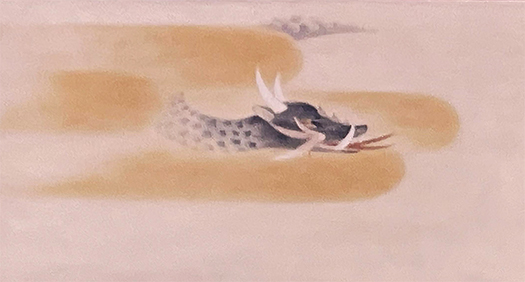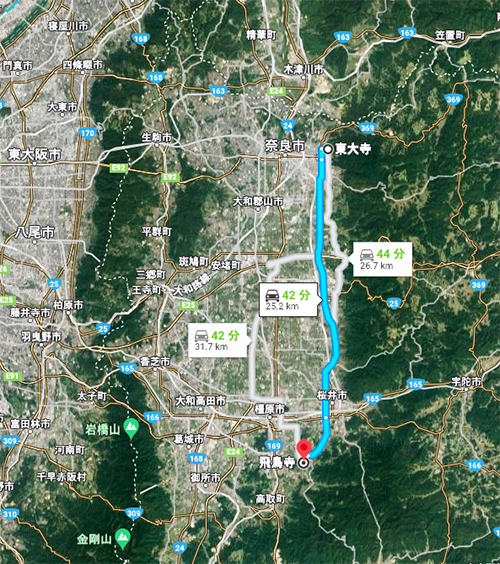


現代の日本の首都は東京。その前は京都。一時期武家政治の中心地として鎌倉も。そしてそれより前は奈良。さらに遡ると飛鳥に至る。飛鳥時代には都の概念は「天皇のいる場所」という意味合いであって、必ずしも都市という概念ではなかった。
聖徳太子絵伝シリーズで見てきた飛鳥時代には、奈良盆地のなかで、あるいは近畿地域のどこかで首都機能、権力中心があったとされる。平城京という日本で初めての条坊制による「大都市建設」が大きな画期であって、寺院建築でも飛鳥寺・法隆寺と東大寺には大きな違いがある。飛鳥の時代とはまったく違うものとして東大寺の建設がなされて、そのひとつの集大成となった大仏開眼会には世界からの賓客を招待して、東アジア世界の新興国家としてその大都市の威容を誇示したのだとされている。
聖徳太子以来、仏教の導入と律令体制という「世界標準」を受容して発展させてきたキャッチアップ型の国家建設過程だったのだと思う。
しかし、わたし的には飛鳥の空気感の方が好きだ。
この時代を代表する歌人である額田王女が都が近江に移って世が移ろっていくときに飛鳥に対して情感を込めて愛惜した歌が伝わっている。「三輪山をしかも隠すか雲だにも、こころあらなも隠さふべしや」。
白村江敗戦という激動に至って彼女を含む多くの王族たちはやむなくより内陸に移っていったのだけれど、彼女の心情がおおくの人びとの内面を表現していたのではないかと思う。
その後、近江遷都を主導した天智帝が崩御した後、壬申の乱によって天智帝の正嫡と戦った天武帝は、戦争に勝利した後、ふたたび飛鳥に戻ってきた。いろいろな事情がそこにはあっただろうが、やはり心情的に飛鳥の地、奈良盆地への愛着が多くの人にあっただろうことも推測できる。
その後、宮城都市の建設地としては飛鳥の地は水利に欠陥があって、平城京に移転していくけれど、かろうじて奈良盆地の最北端に留まることになる。額田王女の思いが実ったとも言えるのだろうか。
さらにもうひとつ、原日本語の残滓が飛鳥時代の言語感覚には濃厚に残されていること。
飛鳥寺周辺を歩きまわっていたとき、ちかくにある神社として「飛鳥坐神社〜あすかにいますじんじゃ」という社名を聞いたとき、そのたおやかな語感にひどく癒される思いがした。まぁ「います」というのは坐という漢字にごくふつうに当てられる読みなのだけれど、古語からの連続性が非常に強く印象される。
飛鳥の地を巡ると、そういう言語感覚が各地で迎えてくれる。けっして漢文調の呼び方ではない地名や故事がたくさん出てくるのですね。まさに国のまほろばでしょうか。
平城京の復元大極殿壁面には龍など十二支の動物絵が描かれているけれど、現代の画工たちによる絵柄にも、こうした飛鳥の空気感がほのかに伝わっている感がある。
English version⬇
The Asuka to Heijo-kyo area, the atmosphere, and the Japanese language.
When the poet Princess Nukata left the Asuka area, she composed a poem of regret and regret. Another characteristic of the area is that the residuals of the original Japanese language remain strong. The Mahoroba of the country. ・・・・.
The capital of modern Japan is Tokyo. Before that, it was Kyoto. For a time, Kamakura was also the center of samurai politics. And before that, Nara. Further back, we come to Asuka. In the Asuka period, the concept of capital meant “the place where the emperor resided” and not necessarily a city.
During the Asuka period, which we have seen in the Shotoku Taishi Pictorial Biography series, there was a capital function or center of power somewhere in the Nara Basin or in the Kinki region. Heijo-kyo, Japan’s first “metropolis” built under a system of monks, was a major milestone, and there are significant differences between Asukadera and Horyu-ji temples and Todai-ji temple in terms of temple architecture. The construction of Todai-ji Temple was completely different from the Asuka period, and the Great Buddha Opening Ceremony, which marked the culmination of the construction, is said to have been an occasion to invite distinguished guests from around the world and to show off the majesty of the metropolis as a newly emerging East Asian nation.
Since the time of Prince Shotoku, the process of nation-building has been a process of catching up with the “world standard” of the introduction of Buddhism and the Ritsuryo system.
However, I prefer the atmosphere of Asuka.
Princess Nukata, one of the most famous poets of this period, wrote a poem about Asuka when the capital was moved to Omi and the world was changing. The poem is titled “Miwasan wo dama dake kaumo datamo kokoroaranamo kakifushiya” (“Even the clouds that hide Mt. Miwa must hide the heart of Asuka”).
Although many of the royal family, including Asuka, had no choice but to move further inland after the upheaval of the defeat at the Hakumura River, her sentiments may have expressed the inner feelings of many of the people.
Later, after the death of Emperor Tenchi, who had led the relocation of the capital to Omi, Emperor Temmu, who had fought against Emperor Tenchi’s legitimate successor in the Jinshin War, returned to Asuka again after winning the war. There must have been various reasons for this, but it can be assumed that many people were emotionally attached to Asuka and the Nara Basin.
Later, Asuka was moved to Heijo-kyo because of its poor water supply, but it remained in the northernmost part of the Nara Basin. Could it be said that Princess Nukata’s wishes bore fruit?
Another thing is that the Asuka period’s sense of language is rich in remnants of the original Japanese language.
When I was walking around Asukadera Temple and heard the name of a nearby shrine, Asukani-no-Izumi-jinja, I was greatly comforted by its gentle sense of language. Well, “isu” is a very common reading of the Chinese character “za,” but the continuity from the ancient language is very impressive.
When I toured Asuka, I was greeted by such a sense of language in various places. There are many place names and events that are not called in the Chinese style. Is this truly the Mahoroba of the country?
On the wall of the restored Daigoku-den Hall in Heijo-kyo, there are paintings of dragons and other animals of the twelve Chinese zodiac signs, and I feel that this sense of Asuka’s atmosphere is faintly conveyed in the designs by modern painters.
Posted on 6月 16th, 2023 by 三木 奎吾
Filed under: 日本社会・文化研究







コメントを投稿
「※誹謗中傷や、悪意のある書き込み、営利目的などのコメントを防ぐために、投稿された全てのコメントは一時的に保留されますのでご了承ください。」
You must be logged in to post a comment.